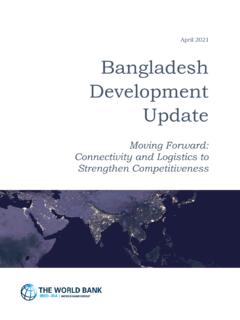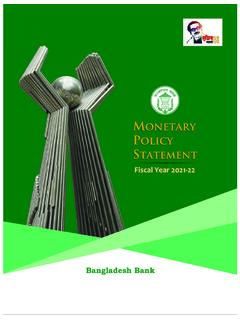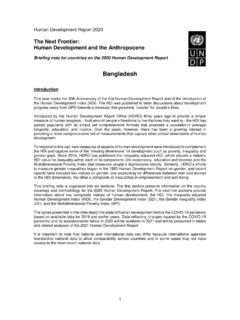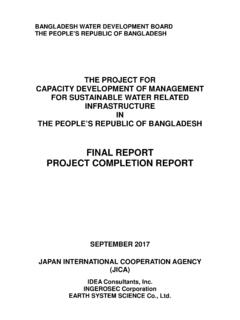Transcription of NATIONAL STRATEGY FOR - UNICEF
1 ADOLESCENT HEALTH2017-2030 NATIONAL STRATEGY FORM inistry of Health and Family WelfareGovernment of the People's Republic of BangladeshNational STRATEGY for Adolescent Health 2017-2030 December, 2016 Published by: MCH Services UnitDirectorate General of Family Planning6, Kawran Bazar, Dhaka-1215 Funded by:UNFPA and UNICEFC over Photo Credit: UNICEF /BANA-2017/KironPrinted by:Color Line, 01715 812345 This document has been developed by MCH Services Unit of the Directorate General of Family Planning with the support of UNFPA, UNICEF and WHOADOLESCENT HEALTH2017-2030 NATIONAL STRATEGY FORMCH Services UnitDirectorate General of Family PlanningMinistry of Health and Family Welfare ^v I cwievi Kj vY g YvjqExecutive SummaryBangladesh has an adolescent population of approximately 36 million: more than one-fifth of the total population of bangladesh is those between the ages of 10 and 19 years (BBS, 2015).
2 This large cohort presents significant potential for the social and economic development of the country if we make the necessary investments to make them healthy and productive. It has been evidenced that investments in adolescent health can bring a triple dividends of immediate benefits, benefits into future adult life and benefits for the next generation of children (Patton et al., 2016). A strong STRATEGY , which identifies key areas for investment, is essential if the overall health and wellbeing of adolescents is to be realized. This NATIONAL Adolescent Health STRATEGY 2017-2030 was developed to address the overall health needs of adolescents by taking a broad and holistic understanding of the concept of health. It also fills a gap where adolescent health issues were not addressed comprehensively in other policy documents. The NATIONAL Adolescent Health STRATEGY 2017-2030 has been developed using a participatory process, with active participation and contributions from key stakeholder groups.
3 Under the leadership of the Ministry of Health and Family Welfare and immediate guidance of the Directorate General of Family Planning, a core committee and several technical committees were established to provide expert input and ensure a comprehensive STRATEGY document. The STRATEGY development process included reviewing of existing NATIONAL and international literature to assess current trends in adolescent health, conducting five divisional consultations with local level stakeholders, conducting four focus group discussions with adolescents, conducting meetings of the core committee and technical committees and organizing a two-day NATIONAL workshop. The final draft of the STRATEGY document was presented to the Inter-Ministerial Committee and finalized subsequent to incorporating their NATIONAL Adolescent Health STRATEGY 2017-2030 has identified four priority thematic areas of intervention: adolescent sexual and reproductive health, violence against adolescents, adolescent nutrition and mental health of adolescents.
4 In addition social and behavioural change communication and health systems strengthening are included as cross cutting issues, which need to be addressed for the effective implementation of the STRATEGY . The management of the NATIONAL Adolescent Health STRATEGY will require an effective management and coordination structure, which has been detailed in the final section of this STRATEGY document. This document highlights the importance of all relevant actors in the development sector both Government and Non-Government working in collaboration with each other if the goal and vision of this STRATEGY is to be realized during the given time period. The NATIONAL Adolescent Health STRATEGY 2017-2030 has been developed for a period of 14 years from 2017 to 2030 to be in line with the Sustainable Development Goals. The STRATEGY envisions that by 2030, all adolescents in bangladesh will be able to enjoy a healthy life and has the goal of all adolescents attaining a healthy and productive life in a socially secure and supportive environment.
5 This STRATEGY is guided by human rights principles and clearly states that all adolescents, irrespective of their gender, age, class, caste, ethnicity, religion, disability, civil status, sexual orientation, geographic divide or HIV status, have the right to attain the highest standard of health. The Ministry of Health and Family Welfare is committed to ensuring the effective implementation of this STRATEGY , which will contribute to the overall wellbeing and health of all adolescent boys and girls of SummaryiiiMessagesvi-xixAcknowledgementx xi-xxiiAbbreviationsxxiii-xxivCHAPTER 1: Adolescents in The Social Context of Adolescent Health02 CHAPTER 2: Commitment and Response to Adolescent bangladesh 's International Commitments to Adolescent Legal and Policy The Health System Response to Adolescent Justification for an Adolescent Health The STRATEGY Development Process05 CHAPTER 3: The The The Time Guiding Principles 07-08 CHAPTER 4: Strategic DirectionsSD1: Adolescent Sexual and Reproductive Health09-11SD2: Violence against Adolescents12-13SD3: Adolescent Nutrition14-15SD4.
6 Mental Health of Adolescents16-17 Cross Cutting Issue 1: Social and Behavior Change Communication19-20 Cross Cutting Issue 2: Health Systems Strengthening21-23 Vulnerable Adolescents and Adolescents in Challenging Circumstances24-25 CHAPTER 5: The Role of the The Role of Other The Role of Development Partners28 REFERENCES29-30 ANNEXURE31-34 Mohammed NasimMessageMessageixMessagexixiiiMessag eMessagexvMessagexviiMessage from UNFPA, UNICEF and Friendly Health ServicesAHSA dolescent Health StrategyAIDSA cquired Immune Deficiency SyndromeARHSA dolescent Reproductive Health StrategyASRHA dolescent Sexual & Reproductive HealthBBSB angladesh Bureau of StatisticsBCCB ehavior Change CommunicationBDHSB angladesh Demographic and Health SurveyBMIBody Mass IndexBMMSB angladesh Maternal Mortality SurveyCPRC ontraceptive Prevalence RateCSOC ivil Society OrganizationDGFPD irectorate General of Family PlanningDGHSD irectorate General of Health ServicesDHDistrict HospitalEmOCEmergency Obstetric CareESPE ssential Service PackageFHIF amily Health InternationalFSNSPFood Security Nutritional Surveillance ProjectGBVG ender Based ViolenceHDRCH uman Development and Research CenterHIVH uman Immunodeficiency VirusHKIH ellen Keller InternationalHMISH ealth Management Information
7 SystemICDDRBI nternational Center for Diarrheal Disease Research, bangladesh ICRWI nternational Center for Research on WomenIFAIron Folic AcidJPGSPHJ ames P Grant School of Public HealthMARAMost At Risk AdolescentsMCHM aternal and Child Health MCWCM other & Child Welfare CenterMMSM ultiple Micronutrient Supplementation MoHFWM inistry of Health & Family WelfareNAHSN ational Adolescent Health StrategyNASPN ational AIDS and STD ProgramNGONon-government OrganizationxxiiiRDRural Dispensary RTIR eproductive Tract InfectionSBCCS ocial and Behaviur Change CommunicationSDGS ustainable Development GoalSRHS exual and Reproductive HealthSRHRS exual and Reproductive Health and RightsSTI Sexually Transmitted InfectionsTTTetanus ToxoidUH&FWCU nion Health and Family Welfare CenterUHCU pazilla Health ComplexUNUnited NationsUNAIDSU nited Nations Program on HIV/AIDSUNESCOU nited Nations Educational.
8 Scientific and Cultural OrganizationUNFPAU nited Nations Population FundUNICEFU nited Nations Children FundUPHCSDPU rban Primary Health Care Service Delivery Project VAWV iolence Against WomenWHOW orld Health Adolescence in BangladeshAdolescence, a near universal life stage of the socialization process, is defined as a period of human growth and development that occurs after childhood and before adulthood and, according to the UN, includes those persons between 10 and 19 years of age (WHO 2014). Adolescence is a time of transition involving multi-dimensional changes: biological, psychological, mental and social ( UNICEF , 2006). Biologically, adolescents experience pubertal changes and changes in brain structure. Psychologically and mentally, adolescents' cognitive capacities mature and they develop critical thinking skills. Adolescents also experience social change as a result of the multiple roles they are expected to play in the family, community and at school.
9 These changes occur simultaneously but at a different pace for each adolescent depending on her/his gender, socio-economic background, education and exposure to various other structural and environmental factors ( UNICEF , 2006). As a developmental phase in human life, adolescence is further divided into early adolescence (10-14 years) and late adolescence (15-19 years). An understanding of these sub-stages of development during adolescence is important from the perspective of policy planning as well as designing and implementing adolescent related programmes. bangladesh has a significant adolescent population. In 2011, more than one-fifth ( percent) of the total population, that is million, were adolescents (BBS, 2011) and according to population projections, both the percentage and absolute number of adolescents will continue to increase until 2021 (UNFPA 2015).
10 It is only by 2031 there will be a decline in the adolescent population of bangladesh highlighting the importance of ensuring this NATIONAL adolescent health STRATEGY is comprehensive and meets the needs of all adolescents, especially the most vulnerable and disadvantaged adolescents. The sheer number of persons in this population cohort, whose health needs have to be addressed, also makes it imperative for this STRATEGY to be effectively implemented. This significant adolescent population presents a demographic window of opportunity, which, if well harnessed and invested in, will contribute to the development of the country . Investment in adolescent health will have an immediate and direct impact on bangladesh 's health goals and on the achievement of the Sustainable Development Goals (SDGs), especially goals 3 (ensure healthy lives and promote well-being for all at all ages), 4 (ensure inclusive and equitable quality education and promote lifelong learning opportunities for all), 5 (achieve gender equality and empower all women and girls), and 8 (promote sustained, inclusive and sustainable economic growth, full and productive employment and decent work for all).


















